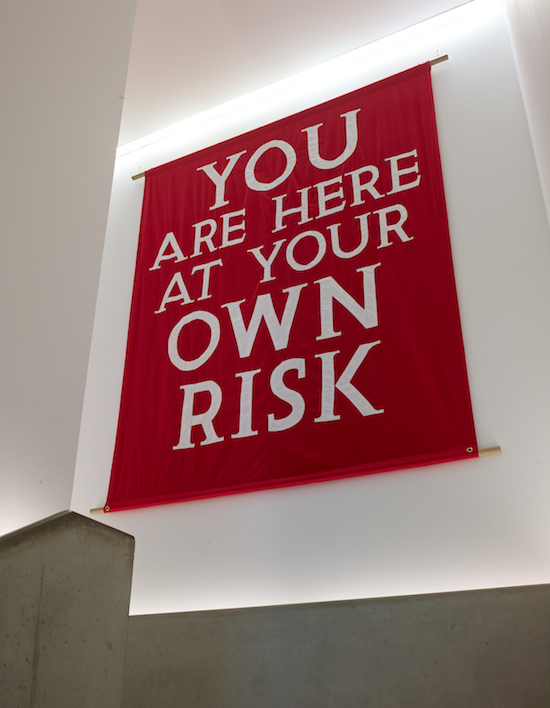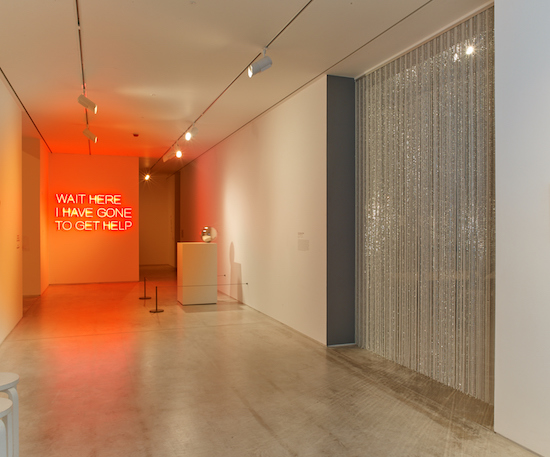Risk, installation view at Turner Contemporary. All photos: Stephen White
Margate is talked about. Branded by lifestyle blogs, judged by journalists, observed by social commentators keen to leave their comments. The narrative vacillates wildly, from giddy acclaim (“the new Hipsters Paradise!”) to spiteful derision (“Grubby and stuck in the past”) from salty naysayers with a story to sew.
Of course, Margate cannot be surmised by either. A town cannot be reduced to a tagline, or captured in one filtered photo. Yet, Margate has clearly hit a shift in her song. The Turner Contemporary has opened to wide-acclaim, with world-class shows and blockbuster artists, leaving a trail to the tune of one and half million visitors. Dreamland, Margate’s cherished theme park, is back. Her turnstiles are turning, dipping the town in a sticky-sweetness; carousels and candyfloss, heady swigs of nostalgia. Both have acted as catalysts for the town, but neither are the cause of the current applause. Margate has always been Margate. Wind battered and beautiful, resilient and resplendent, a tough little seaside town that is quick to inspire devotion.
At the Turner Contemporary gallery by the seafront, Pedro Reyes’ Disarm project turns illegal weapons seized by the Mexican Government into musical instruments. Repurposed remnants of violence, strings pulled across pieces of pistols, shoulder stock bodies and trigger bridges. As sculptures they possess a steampunk quality, with playful nods to the audacious shapes of thrash metal. The guitar would not look out of place in the arms of Kerry King, if Slayer wielded welded axes. The instruments are of course all gunmetal grey. Their dull lack of shine is sinister: these weapons have been used.
It is in their revived use that Reyes’ project excels. The instruments are sculptures, yes, but music-makers first. In the Turner Contemporary they are played by mechanized automation, whirring into life at regular intervals, colouring the clean white lines of the gallery. Reyes suggests that the music they make is “a requiem for lives lost”. In this instance the song is celebratory, shuffling beats and rousing melodies, performed by seemingly autonomous instruments.
The instruments, however, can also be played manually, as they were at the Tom Thumb Theatre, a mile down the coast towards Walpole Bay, in August. Here Disarm was illuminated from a different angle. Replacing the grandeur of the gallery with the rough intimacy of a DIY arts venue, it revealed a palpable immediacy. The violence felt within reach. Accordingly, holding the instruments is affecting. The gravity of Disarm, is mirrored in the sheer weight of the objects. The guitars dig into your lap, playing the flute (or, blowing down the barrel of a gun) causes your arms to ache. And, like the theory in your thoughts, the smell of metal lingers on your fingers.
Upstairs an exhibition exploring Risk unfolds: films made in the eye of a tornado, burning planes, arrows held to the heart (Marina Abramovic & Ulay’s famous Rest Energy performance piece, from 1980). It is perhaps Turner Contemporary’s most theatrical show to date. Many of the works document acts or forces; they are reflections of an action, affirmations of a physical event.
KI-AI 100 (100 Cheers), for example, is a video piece by Chim↑Pom, a provocative artist collective from Tokyo. The recording reveals a performance in Soma City, a town destroyed by the nuclear disaster at Fukushima in 2001. Here they collaborate with local teenagers they befriended in the area, young people who – despite losing homes, friends, families in the accident – were risking radiation sickness to helping with the clear up operation.
Together they formed a scrum, arms hooked, shoulder to shoulder, around a camera facing up at them. From here they performed 100 KI-AI, loud shouts used in Martial Arts to focus energy before attack. In turn, they each call out dedications, inspirational proclamations or simple observations. Together they cheer, then move on to the next. (“I’ll do my best!” cheer, “For my grandfather!” cheer, “I wanna see cute girls in swimsuits soon!” cheer). It is a poignant, gloriously idiosyncratic snapshot of a specific moment in a specific place at a specific time. A circle of faces and voices, veering in and out of focus.
In keeping with the theatrical quality, the gallery is scattered with instructions and directions, inviting the audience into an active role. On one wall neon lights are folded into the words “Wait Here I Have Gone To Get Help” (fittingly, the work is by Tim Etchells, Artistic Director of the acclaimed performance company Forced Entertainment). On another towers Jeremy Deller’s warning “You Are Here At Your Own Risk”. The statements inform the artist / spectator relationship, nudging at boundaries and testing the edges.

Which brings me on to Margate, a town that nudges at boundaries, that tests the edges. Besides a cut felt sculpture, buried in the gallery’s guide, are the words of Robert Morris: “Making art is about going through with something”. This attitude is prevalent in Margate. People make things, people do things. As a result there is a buoyant, vibrant, DIY arts scene and a community unlike any I have experienced.
It’s testament to Margate that a town with just 50,000 inhabitants can house so many galleries. It can host noise nights in an old substation, performance art in abandoned shops, gigs in a furniture depository, screenings in a builders yard. It is testament to Margate that it boasts a thriving WI, cafes that have held regulars for forty years, bus stops brimming with conversation. A corner of the country, bubbling with wit and weirdness. A town where a visit to the hairdressers is interrupted by a wake in the pub opposite, when the mourners conga through the salon (dressed in black, chanting "let’s all do the conga"). A town where a visit to Morrissons always returns a story. A town where I have witnessed mobility scooters races down the centre of the high street. Twice. A town where people gather to toast the tide, raise a glass to the sunset. A town where I cannot finish writing because four strangers have approached me to pass the time with chat. Entirely apt: Margate is talked about, Margate is talked at, but Margate is perfectly capable of leading the conversation.
Risk is at Turner Contemporary, Margate, until 10 January 2016



